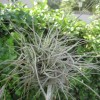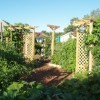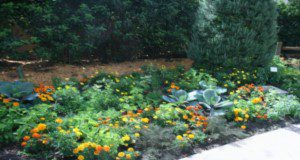Maintaining edible landscapes in a way that protects the environment is an important concern for protecting Florida’s water quality. The objective of this new 7-page publication is to introduce the framework of the Florida-Friendly Landscaping™ principles and apply the principles to guide decisions about Best Management Practices (BMPs) for care of edible landscapes. Written by Tiare Silvasy, Lynn Barber, Esen Momol, Tina McIntyre, Tom Wichman, Gail Hansen, Jen Marvin, Terra Freeman, Joseph Sewards, Wendy Wilber, and Jacqlyn Rivas.
https://edis.ifas.ufl.edu/ep594
Tag: Joseph Sewards
Spanish Moss, Ball Moss, and Lichens – Harmless Epiphytes
 Epiphytes are “air” plants that survive on moisture and nutrients in the atmosphere. Several epiphytic plants, like Spanish moss, ball moss, and lichen, are common to the Florida landscape and southeast United States. People unfamiliar with epiphytes sometimes worry that they may cause injuries to the plants they perch in. Epiphytes do attach themselves to plants, but they do not harm the plants, unlike mistletoe, a plant parasite. Without soil as a source of nutrients, epiphytic plants have evolved the capacity to obtain minerals dissolved in water that flows across leaves and down branches. This 3-page fact sheet was written by Joe Sewards and Sydney Park Brown, and published by the UF Department of Environmental Horticulture, September 2013.
Epiphytes are “air” plants that survive on moisture and nutrients in the atmosphere. Several epiphytic plants, like Spanish moss, ball moss, and lichen, are common to the Florida landscape and southeast United States. People unfamiliar with epiphytes sometimes worry that they may cause injuries to the plants they perch in. Epiphytes do attach themselves to plants, but they do not harm the plants, unlike mistletoe, a plant parasite. Without soil as a source of nutrients, epiphytic plants have evolved the capacity to obtain minerals dissolved in water that flows across leaves and down branches. This 3-page fact sheet was written by Joe Sewards and Sydney Park Brown, and published by the UF Department of Environmental Horticulture, September 2013.
http://edis.ifas.ufl.edu/ep485
Design and Implementation of Edible Plant Demonstration Gardens: A Case Study of the Putnam County Extension Edible Garden (ENH1205/EP466)
 Demonstration gardens are a collection of plants assembled and organized in a manner that allows garden visitors to access and study them. Most gardens are designed with a particular focus and include plants that support the purpose and educational theme of the garden. This case study features an edible plant demonstration garden that was designed and installed in Hastings, Florida, on the Extension office grounds. The UF/IFAS program and the Partnership for Water, Agriculture, and Community Sustainability (FPWACS) designed and implemented the demonstration garden using a step-by-step process that is discussed in this 15-page fact sheet written by Gail Hansen, Joseph Sewards, Rebecca Almeida, and Andrew Dunn, and published by the UF Department of Environmental Horticulture, November 2012.
Demonstration gardens are a collection of plants assembled and organized in a manner that allows garden visitors to access and study them. Most gardens are designed with a particular focus and include plants that support the purpose and educational theme of the garden. This case study features an edible plant demonstration garden that was designed and installed in Hastings, Florida, on the Extension office grounds. The UF/IFAS program and the Partnership for Water, Agriculture, and Community Sustainability (FPWACS) designed and implemented the demonstration garden using a step-by-step process that is discussed in this 15-page fact sheet written by Gail Hansen, Joseph Sewards, Rebecca Almeida, and Andrew Dunn, and published by the UF Department of Environmental Horticulture, November 2012.
http://edis.ifas.ufl.edu/ep466
